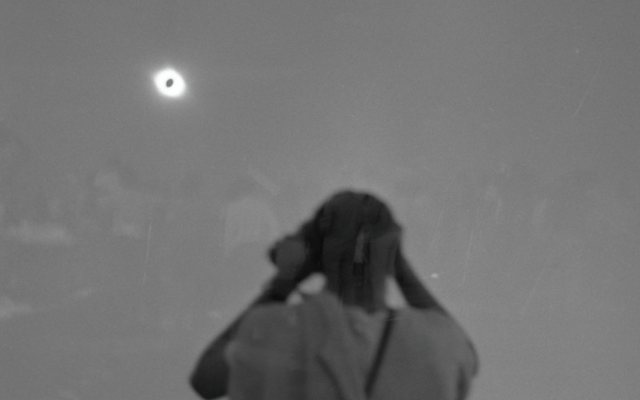
How Maine prepared for its last total solar eclipse 60 years ago
By Emily Burnham, Bangor Daily News Staff
While Mainers pull the final elements together for total solar eclipse festivities next month, for some folks, this is not their first go-round with such a rare celestial event. The last time a solar eclipse hit Maine was on July 20, 1963, a little more than 60 years ago. Then, as now, it was a really big deal for the state.
The eclipse wasn’t on very many people’s radars until the fall of 1961, according to a 1963 Down East magazine story, when Norbert X. Dowd, president of the Bangor Chamber of Commerce, received a call from someone asking where might be a good spot to watch the eclipse, since the city was right in the path of totality.
Dowd quickly realized the city had a golden opportunity to attract many thousands of visitors, and began marshaling a city-wide effort to convince hotels, restaurants and community organizations to take advantage of it.
At around the same time, an astronomer in Prospect Harbor, Carroll Merriam, had written a letter to Gov. John Reed, informing him that not only was Maine in the path of totality, but the only other U.S. state it would pass through was Alaska. Merriam became Maine’s unofficial scientific spokesperson. Ironically, Reed left Maine during the eclipse in order to attend the National Governor’s Conference.

1963 ECLIPSE – A total solar eclipse last crossed Maine on Saturday, July 20, 1963, in a path that swept southeast from The Forks through Skowhegan, Bangor, Ellsworth, and Bar Harbor.
What’s more, the eclipse would happen in the late afternoon on a Saturday, in the middle of Maine’s glorious summer. It was almost as if it was planned by the tourism board.
Projections for the amount of visitors the state would see started at a conservative 10,000, but rose to around 100,000 by spring 1963. By the summer, some projected a whopping quarter-million would come to Maine. The Bangor Daily News exhorted readers in an editorial to do their civic duty and tell everyone they knew that an eclipse was coming, and to come to Maine for it.
State officials warned businesses not to price gouge visitors on things like lodging, food and gas. Maine’s Department of Transportation worried that spectators arriving en masse would create the worst traffic jam ever seen in Maine — the “greatest mass movement of motor vehicles in its history.â€
Scientists both professional and amateur were set to flock to the state for the big day. The Astronomical League held its annual convention at the University of Maine to coincide with the eclipse, and NASA sent a team of scientists to a remote location near Caratunk to use the opportunity to clearly see comets that are otherwise too faint to be observable from Earth. Oceanographers from the National Academy of Science also planned to observe how schools of herring off the downeast coast would behave during the blackout.
Unlike this year’s eclipse on April 8, which will last up to 3 minutes and 26 seconds in parts of the state, the 1963 eclipse only had a max of about 60 seconds of totality. The path of the eclipse began in the northwest corner of the state and crossed southeasterly, passing through communities including Greenville, Dover-Foxcroft, Dexter, Bangor, Old Town, Belfast, Ellsworth and Deer Isle, before exiting the state just off Mount Desert Island, in a 55 mile wide swath. The summit of Cadillac Mountain in Acadia National Park, a prime viewing spot, had all 850 available parking spaces snapped up months ahead of the big day.
The Bangor chamber fielded requests from high schools throughout the Northeast that wanted to bring their students. Dover-Foxcroft planned an “Eclipso†concert, presumably performing calypso music, with its 85-person town band. Ellsworth planned its bicentennial festival for that week, and the town of Dexter — at the center of the totality — postponed its Fourth of July celebrations to coincide with the eclipse.
Towns and schools distributed eclipse glasses, ophthalmologists warned about eye damage from staring at the sun, and photography companies ran advertisements about how to get the best photos without ruining your film — or your eyes.
In the days right before the eclipse, the biggest question on many Mainers’ minds was not just how many people would show up, but whether or not cloud cover would ruin the entire thing. The BDN teased the weather forecast on the front page each day for the week leading up to the eclipse, before it became clear on Friday that the day would be mostly sunny, with only about 30 percent cloud cover over parts of the state. Some areas had less favorable viewing conditions, but the majority had a clear view.
When all was said and done, Maine’s Department of Economic Development estimated that between 100,000 and 150,000 people came into the state for the eclipse, providing an estimated $10 million boost to the economy — nearly $100 million in 2024, adjusted for inflation. All that planning did, in fact, pay off.
The BDN, many scientists and organizers did get one big thing wrong, however. Astronomers including Merriam told the media at the time that the next solar eclipse would not pass over Maine until 2079. Others claimed it would not happen again until 2106. Their calculations clearly were incorrect — 61 years later, we’re gearing up for our next eclipse, with the same level of preparation, anticipation and excitement as we had back then.